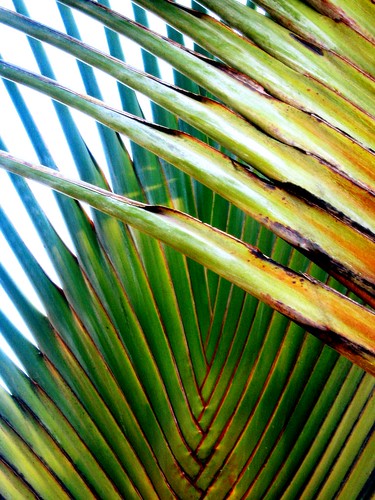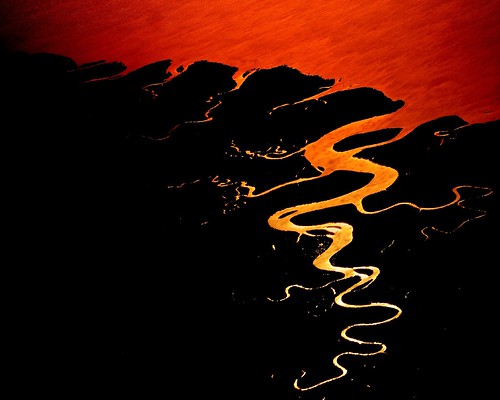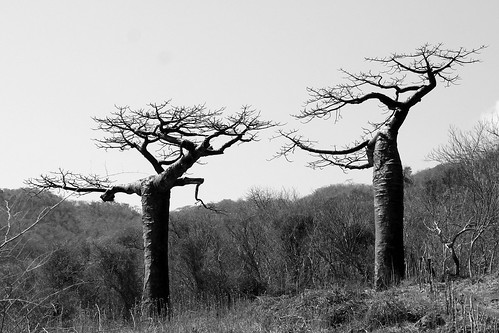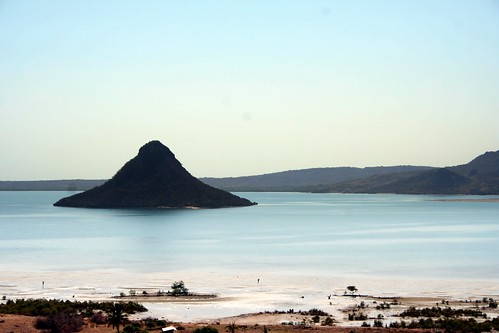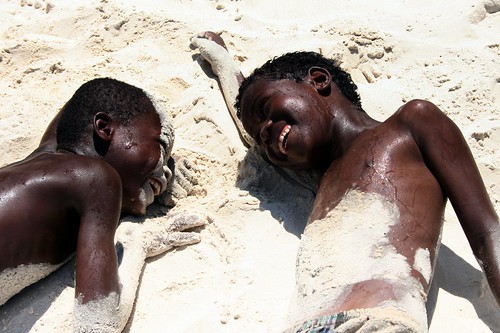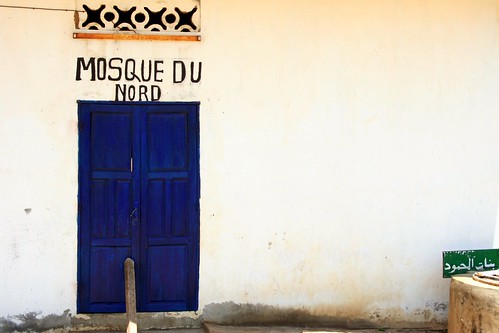48 hours in Diego Suarez, Madagascar (Day 2)
continued from Day 1
Montagne d’Ambre
We woke up early at The Nature Lodge, excited about our itinerary that morning, the Amber Mountain, or as they say it there, the Parc Montagne d’Ambre. I did my research and found out that it is the most visited destination in North Madagascar being one of the most biologically diverse places in the country. We knew we would be venturing inside a jungle so we dressed for it, in sneakers ready to trudge on muck, in jeans to fend off mosquitoes or whatever insect that might take a liking for human flesh and with caps on to keep us somewhat dry. Tropical forests are hot, humid and wet.
The road was unpaved, jagged and muddy but our experienced driver (Eric, cel +261 331292765, about $30-50/day in 2005) was adept in maneuvering his old Citroen over mud, boulders and gigantic tree roots. In 30 minutes, by about 8AM, we already found ourselves at a small building fronting the Park. Imagine our chagrin when the park secretary informed us that we could not visit the park without a guide and that all guides were already bookedZ. Apparently we should have made advance arrangements as there are only a few guides. We asked our driver to help us cajole and implore the staff in finding us a guide. For what seemed like an hour we waited – okay, it was just 15 minutes really but we were scared white – until the secretary came back with her brother Angeluc. He volunteered to be our guide. So off we went.
Fantastic luck. Razafimanantsoa Angeluc (family name comes first in Malagasy) had an encyclopedic knowledge of the place, born from someone who grew up in the area. He was loquacious and told us that after high school he went to Tana and worked as a research assistant in a biology lab in a university. I think he studied there too for awhile. He was now working as a Tana-based guide specializing on wildlife tours in any point in Madagascar. He mentioned gigs with international photographers and videographers. Maybe so. His English was fluent and most of all, he knew the scientific names of most plants, animals and insects in the forest reserve. Taking down notes of his commentaries was difficult because he had a lot to say!
The national park was created in 1958 and covers 18,200 hectares of prominent volcanic massif. The billboard at the entrance proclaims that it has 75 different species of birds, 25 species of mammals, and 59 species of reptiles. The latter group includes frogs, geckoes, chameleons and snakes. Of the seven lemur species in the park, the most notable are the crowned lemur and Sanford's brown lemur. I did not have any telephoto lens then so my lemur pictures were miserable.
Personally, I was dying to see the chameleons. Imagine a lizard which could change colors in response to light, heat, and other stimuli! The island is home to 54 or two-thirds of all the world's chameleon species.
Canon EOS 350D, 0.002s, f/5.6, 45mm, ISO 100
a chameleon in the Amber Mountain Park, Diego Suarez (Antsiranana), Madagascar, East Africa
Chameleons range in size from the giant Chamaeleo oustaleti which measures up to 68 cm (27 inches) long to the diminutive Brookesia minima which reaches only 3 cm (1.3 inches). Chameleons are Old World lizards that dwell in trees, except for the stump-tailed chameleon, Brookesia, which lives mainly on the forest floor. We only saw 4 but that's enough for me. 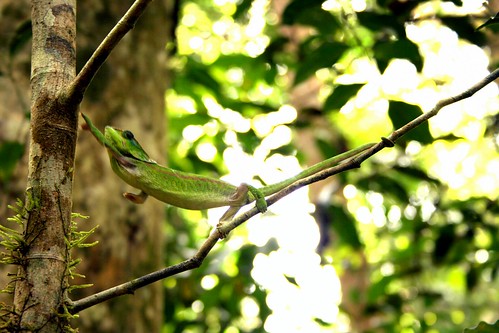
phototip: Be quick. Some creatures don’t hold their pose.
Canon EOS 350D, 0.05s, f/5.6, 52mm, ISO 100
a chameleon in the Amber Mountain Park, Diego Suarez (Antsiranana), Madagascar, East Africa
The park has several water falls and crater lakes and being a true rainforest, it is a botanist’s dream. It boasts of roughly 20km of maintained tracks allowing close contact with the lush wildlife.
phototip: Underexpose a sunrise shot to get silhouettes.
Canon EOS 350D, 0.013s, f/5.6, 27mm, ISO 100
Cascade Antamboka, the Amber Mountain Park, Diego Suarez (Antsiranana), Madagascar, East Africa
On our way out of the forest, there was one final treat. While the car was speeding, Angeluc suddenly asked the driver to stop and backtrack. He saw something on the track – the chameleon below. Now, those are eagle eyes he has. It was only 10cm long!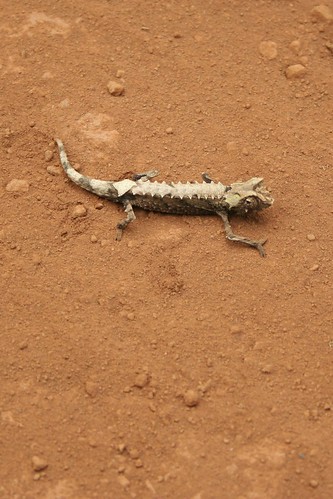
phototip: Underexpose a sunrise shot to get silhouettes.
Canon EOS 350D, 0.002s, f/5.6, 55mm, ISO 200
a Brookesia chameleon in the Amber Mountain Park, Diego Suarez (Antsiranana), Madagascar, East Africa
City Tour
Of course, what is a trip to Diego Suarez without having a city tour? We had the taxi drop us at Rue Colbert, the main thoroughfare. From the map, we could tell that the city center is small enough to be explored on foot.
Historically, Madagascar was a notorious pirate's lair in the age of colonialism, when merchant ships in the Indian Ocean, the Red Sea and the Persian Gulf were easy prey. Legend says that in the late 1700s, a strange community named Libertalia settled in Diego Suarez, now Antsiranana. 
Canon EOS 350D, 0.005s, f/11, 41mm, ISO 100
a mosque the Cathedral, Diego Suarez (Antsiranana), Madagascar, East Africa
The name Diego Suarez harbor was derived from Diego Diaz, who came to Madagascar in 1500 and a sailor, Fernando Suarez who visited in 1506. The story and the legend say that:"Towards the end of the 17th century, a strange community settled in the Bay area and gave birth to the Libertalia Republic. Characters that were closely related to buccaneering: a French pirate named Misson, and a Roman priest, Angelo Caraccioli. They were both inspired by a utopian philosophy based on the freedom of men, religion and races. Libertalia thrived for a few years until the Malagasy, aroused by their chiefs that hardly understood this threat to their authority, attacked Libertalia by surprise and destroyed it".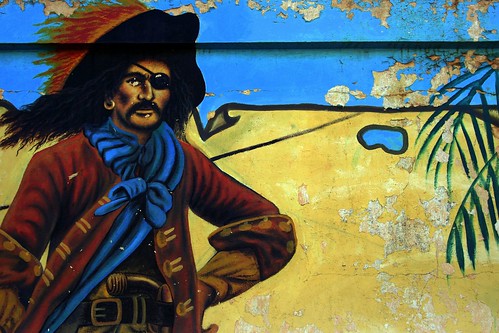
Canon EOS 350D , 0.008s, f/8, 40mm, ISO 100
a wall mural in Diego Suarez (Antsiranana), Madagascar, East Africa
As a developing nation, Madagascar cannot spend much for infrastructure but surprisingly, Diego Suarez has roads that are well-paved, clean and free from potholes probably because there are not a lot of cars. It helps that the city does not get a lot of heavy truck traffic. To add to its picturesque look, almost all of the taxicabs and cars on the street were 1950-70s cars, either Renault or Citroen, that are still in surprisingly good running condition.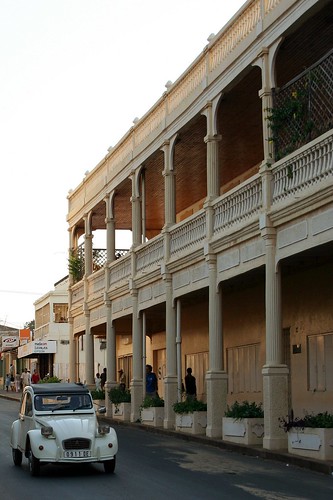
Canon EOS 350D, 0.008s, f/8, 38mm, ISO 100
Rue d' Colbert, Diego Suarez (Antsiranana), Madagascar
Within just a 200 meter radius are two mosques, a Hindu temple and a Christian Cathedral. The latter was closed when we visited it early in the afternoon but it looks Catholic. It is a multicultural society.
Canon EOS 350D, 0.002s, f/5.6, 18mm, ISO 100
a Cathedral in Diego Suarez (Antsiranana), Madagascar, East Africa
Diego Suarez retains the charm of an old French colonial city, having been under French rule from 1896 to 1960. A lot of colonial buildings still stand, replete with ionic columns and balustrades, mostly crumbling and flaking but no less elegant. Locals, expats and tourists alike seem to take lounging and promenading to a habit. Had we stayed in town any longer, we probably would have found ourselves watch time pass by in any of its Arabic tea parlors, French cafes or Italian bakeshops. But we needed to go to the airport and catch a flight.
Looking back, I want to think that little has changed today in Diego. Time has been kind to it for the longest time and maybe it still is.
Canon EOS 350D, 0.002s, f/5.6, 25mm, ISO 100
awning at La Rosticceria where we had lunch, Rue Colbert, Diego Suarez (Antsiranana), Madagascar, East Africa






